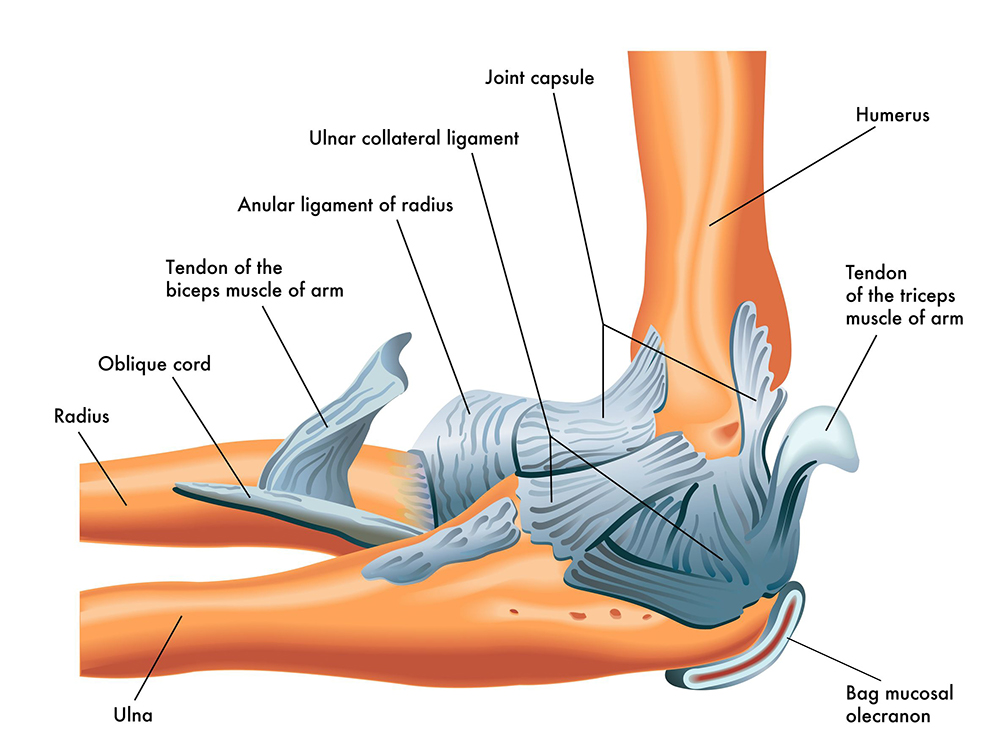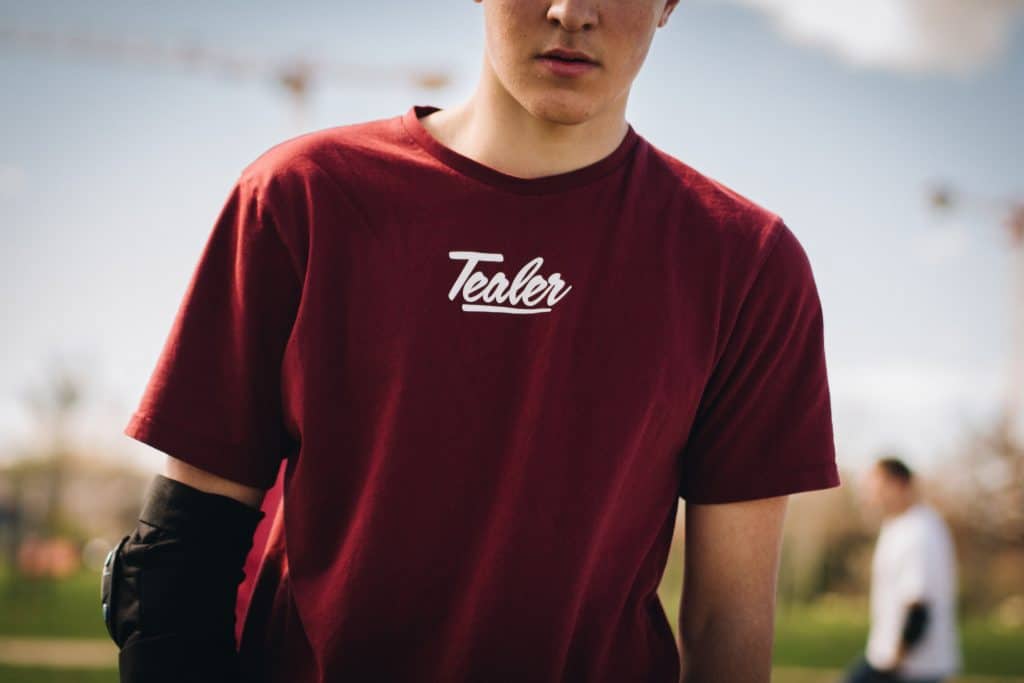What Causes Elbow Bursitis?
Also known as Popeye’s elbow, elbow bursitis has the characteristic look of a bulbous lump on the tip of one’s elbow.
Elbow bursitis is caused by a hard blow to the elbow, an extended period of pressure on the tip of the elbow, an infection, or certain medical conditions like arthritis and gout. Most cases of this painful swelling can be treated non-surgically in under six weeks.
Elbow Anatomy

Your elbow, medically referred to as the olecranon, has a protective fluid-filled sac on its tip called a bursa. Elbow bursitis is specific to the inflammation of this bursa. Inflammation in the connective tendons of the elbow is called tennis elbow.
We have many bursae between the bones and soft tissue throughout our bodies. Bursae act as cushions and lubricating agents for proper joint movement. Normally these bursae are flat, but when they fill with fluid due to inflammation or irritation, it is called bursitis. The pain caused by bursitis may be immediate or develop over time.
Elbow Bursitis Causes
The most common causes of elbow bursitis are injury (such as a sports injury), prolonged pressure, infection, and certain medical conditions.

Injury: The most common cause of olecranon bursitis is injury. A hard, traumatic blow to the end of the elbow can cause the bursa to swell from excess fluid production. According to the Cleveland Clinic, over 66 percent of cases of non-infectious bursitis are caused by injuries.
Pressure: Bursitis due to extended periods of pressure usually takes several months to develop. Students, workers in certain fields, and athletes (like baseball players) are susceptible to elbow bursitis. This is due to leaning on their elbows for long periods or repetitive motions (like lifting weights) that put repeated pressure on their bursa.
Infection: Most cases of elbow bursitis caused by infection result from cuts, scrapes, or insect bites. Since the bursa sac is so close to the skin, bacteria enters through these wounds and leads to infection. As with other bursitis-causing events, the bursa swells and produces excess fluid. If the infection is untreated, the fluid turns into pus.
Other medical conditions: Conditions like rheumatoid arthritis, diabetes, thyroid disease, and gout can lead to olecranon bursitis.
Elbow Bursitis Symptoms
The first and most obvious symptom of bursitis of the elbow is swelling. As the swelling continues, the bursa stretches to accommodate extra fluid, which causes elbow pain. This pain is typically at its worst when you lean on or bend your elbow. The swollen, painful elbow becomes hard to move.

If an infection caused your bursitis, additional symptoms like redness and being warm to the touch are often present. In cases of olecranon bursitis associated with a wound, pus may drain from the infection. If the infection remains untreated, it can spread to the rest of the arm or throughout the body.
Tests and Diagnosis
An orthopedic specialist might use a physical exam, X-ray, ultrasound, or MRI to diagnose elbow bursitis. It’s important to determine whether the bursitis is acute or chronic and septic or aseptic. These determinations allow the elbow specialist to develop a proper treatment protocol.
Additional tests may be necessary for chronic cases to determine whether the swelling is from a bone spur or an underlying condition. Septic cases require bursal fluid or blood testing. Testing determines the infection’s cause and proper treatment to prevent the infection from spreading to the body.
Elbow Bursitis Treatment at Home
Initial treatment of bursitis of the olecranon includes resting the elbow and avoiding any activities that put direct pressure on the elbow. Compress the elbow and ice it for 15 to 20 minutes 2 to 3 times daily to help with the pain and swelling. Use an elbow pad to cushion and protect the elbow. Take a non-steroidal anti-inflammatory like ibuprofen as directed by your orthopedic doctor.
Another standard treatment for elbow bursitis is to aspirate the bursa. This is an outpatient procedure where your specialist uses a needle to drain the built-up fluid. Aspiration helps relieve symptoms, and testing the fluid helps determine the cause of the swelling.
If the bursitis is due to infection (septic bursitis), your provider will prescribe antibiotics. Most cases resolve with at-home treatments in under six weeks.
If the pain and swelling from a case of elbow bursitis continue for weeks into months or are particularly disruptive to your day-to-day life, your orthopedic elbow specialist may use a corticosteroid injection to relieve the pain and swelling.

Surgical Treatments for Elbow Bursitis
Surgery for elbow bursitis is rare but may be necessary if the bursitis is due to an infection. If neither aspiration of the bursa nor antibiotics resolve the issue, an orthopedic surgeon may remove the infected bursa. A new, normal bursa usually grows back over the coming months.
You may be required to wear an elbow bursitis brace post-surgery. Long-term casts are usually unnecessary.
Extensive physical therapy is also typically unnecessary. Your orthopedic surgeon will likely recommend a few exercises to help you regain full range of motion as you heal.
The timeline for surgical recovery is usually reasonably short. You will likely be released to use your elbow after a few weeks. It is best to use a pad or elbow protector for several months to prevent further injury.
Bursitis Prevention
The best way to prevent elbow bursitis is to avoid putting excess pressure on your elbows. Give yourself periods of rest between jobs or intense exercise sessions, and wear proper protective elbow pads when necessary.
See an orthopedic specialist if you have elbow swelling, pain that interferes with your daily activities, soreness that is not improving, redness and warmth around your elbow, or bursitis that continues to return.
If you would like to talk to one of our orthopedic specialists or if you have questions about an elbow injury or symptoms, please get in touch with us or comment below.
13 Comments
Permalink
I was diagnosed with gout in 1995, in 2017, I had a severe gout attack in my left elbow and swelled up to the size of an orange. Now the birds is hard and hurts when I lean on it. I might need to get it surgically fixed. Any ideas?
Permalink
Hi Richard,
Surgery isn’t usually our first option. Instead, we’ll prescribe a round of non-steroidal anti-inflammatories to decrease redness, pain and swelling. But if that stubborn gout doesn’t go away, you will certainly want to follow up with an orthopedic specialist
Permalink
I have an elbow bursa tried to drain using18 gage needle very sterile technique but no fluid in it. It has gone down some in weeks but still remains.
Why no fluid, what is it?
Permalink
Hi Joe, there could be various reasons why you weren’t able to drain any fluid from your elbow bursa despite using a sterile technique. It’s important to note that attempting medical procedures without professional guidance can be risky, and it’s advisable to consult with a healthcare professional for accurate diagnosis and proper treatment. The possible reasons for the lack of fluid drainage could be due to incorrect needle placement or clotted or minimal fluid. There could be other reasons for elbow swelling such as inflammation, infection, or a different underlying condition. If you are experiencing persistent symptoms, consult with a healthcare professional promptly to ensure proper diagnosis and management.
Permalink
I banged my elbow about two months ago. It swelled up, turned puple and eventually went back to normal. However, when I rest my elbow on a surface now in a certain way, I just about go through the roof from a very sharp pain. It feels like there’s a raw nerve in there.
Any idea what’s going on?
KL
Permalink
Kirk, it sounds like you may have experienced more than just a simple bump on your elbow. The initial swelling and discoloration might indicate some level of trauma, and the lingering pain could be a sign of ongoing issues.
It’s important to follow up with an orthopedic specialist to get a proper diagnosis and treatment plan. They will assess your situation, possibly through imaging like X-rays or an MRI, and provide personalized advice based on your specific condition. It’s crucial not to ignore persistent pain, as it could indicate an underlying problem that needs attention.
In the meantime, consider avoiding putting direct pressure on your elbow in the way that triggers the sharp pain. Applying ice and over-the-counter pain relievers might help alleviate some discomfort, but these are just temporary measures. Make sure to seek professional medical advice for a comprehensive understanding of your situation and appropriate guidance on how to manage and treat your elbow pain.
Permalink
I have an accident 10 years ago qnd dislocated my elbow. For tge last 3 years i’m starting to have gout and usually they attacked my legs however for the past 3 days i had started to feel similiar pain on my left elbow. Feeling of excruciating constant pain and soreness feeling on the top left of my elbow.
My question, can gout effect my left elbow and does this had anything to do with my previous accident
Permalink
Hi Muhammad, it’s possible for gout to affect joints, including elbows. The connection between your previous elbow dislocation and the current pain is uncertain. I would recommend you consult with a healthcare professional to evaluate your symptoms, medical history, and perform necessary tests to provide appropriate treatment options.
Permalink
I noticed this weird swelling on my right elbow about two weeks ago.
But since I felt no pain or major discomfort,plus it didn’t look like much,I totally ignored it,until last week when while wearing a t-shirt at a park,a family member spotted it and drew my attention to it.
Then another friend mentioned it as well,
That was when I started to get uncomfortable
I actually thought it was unnoticeable and it would probably leave the same way it came,besides,I feel almost no pain,just some mild rubbery numbness.
Should I be worried?
Permalink
It’s great that you’re paying attention to your body and seeking advice. While I can’t offer a diagnosis, I recommend consulting with an orthopedic specialist about the swelling on your elbow, especially since it has caught the attention of others and you’re experiencing some discomfort. It’s always better to address these concerns early to ensure your health and well-being.
Permalink
Can this condition smart off as a small lump? All the pics I’ve seen of it , it’s always golf ball or larger size. (Mine is also red hot to touch and sore)
Permalink
Hi Ashley, elbow bursitis can sometimes present as a small lump, especially if there is significant swelling or inflammation of the bursa. The redness, heat, and soreness you’re experiencing are common symptoms of bursitis, indicating inflammation in the bursa sac. It’s essential to have it evaluated by a doctor to confirm the diagnosis and determine the appropriate treatment, which may include rest, ice, anti-inflammatory medications, and possibly aspiration of the bursa fluid or other interventions.
Permalink
I fell through my mamas bridge 2 months ago and j think that’s when I got this burcitis